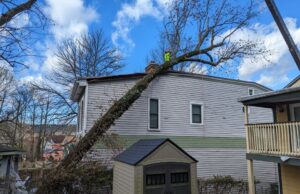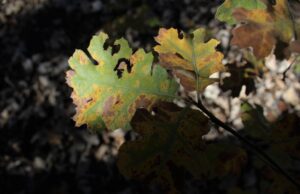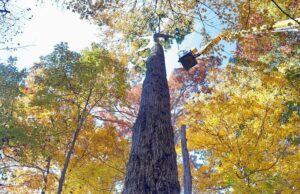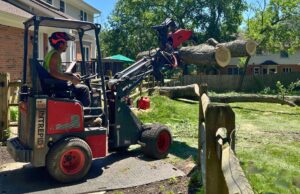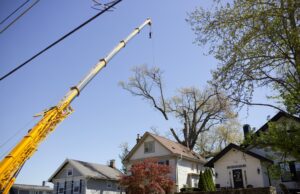More and more homeowners in the Cincinnati area are interested in planting native trees in their yards, as well as on commercial properties and in public spaces. And for good reason.
Trees native to Cincinnati tend to require less maintenance, less water, and fewer soil amendments since they have thrived in the soil and climate conditions in Southwest Ohio and Northern Kentucky for thousands of years. While no trees are truly maintenance-free, native species are as close as they get.
Our native Ohio trees also benefit local wildlife like butterflies, birds, and mammals like deer and squirrels, supporting the entire natural ecosystem by providing important food and nesting sites that non-native species don’t.
If you’re looking to add relatively low-maintenance trees to your landscape that support biodiversity in our region, keep reading to discover our favorite trees native to Cincinnati and the surrounding areas.
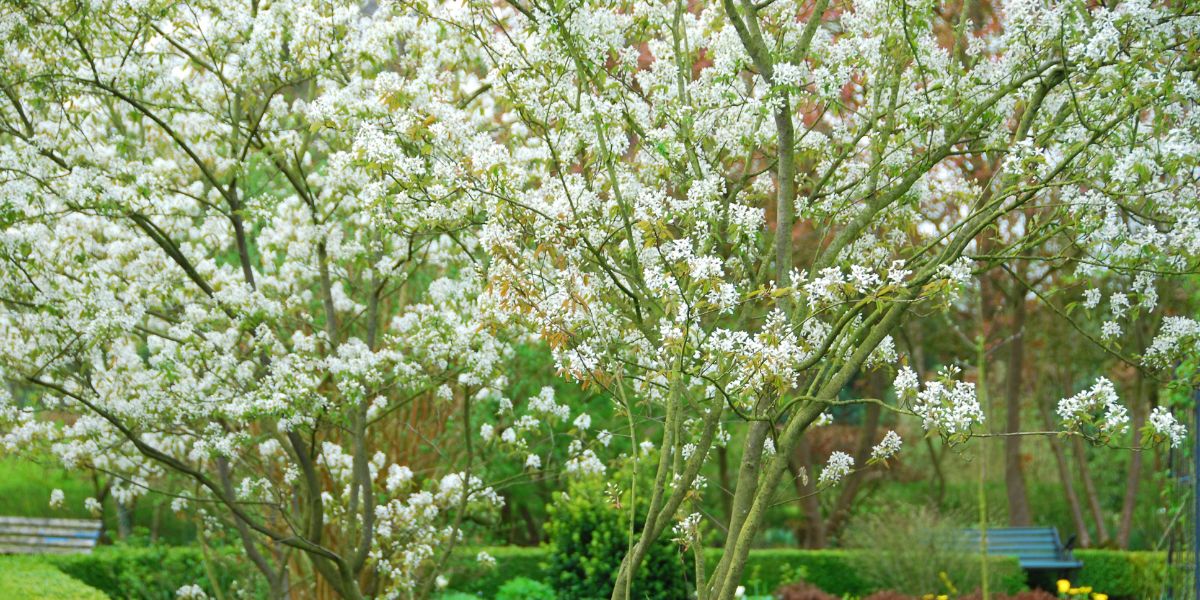
Serviceberry tree in full bloom.
1. Serviceberry (Amelanchier spp.)
Serviceberries (Amelanchier spp.) are small, showy, understory trees that are quite popular with homeowners on smaller lots. While they don’t grow big, they make a big statement each spring as the entire tree is covered in white flowers, adding visual interest to your yard.
These flowers are an important early-season nectar source for various bees. It may even sound like the entire tree is buzzing at times. Due to its popularity with bees, it may be best to plant this away from playgrounds or areas frequented by smaller children.
The serviceberry hosts over a hundred butterfly and moth species. As the fruit ripens from pink to blue early in the summer, these trees are favored by birds as a food source. They are likely to draw robins, orioles, catbirds, thrushes, and many other bird species to your yard.
Serviceberries usually have multiple trunks, though with regular tree pruning, you can train these into a single trunk specimen. You can also plant them in full sun or shade, making it easy to find the perfect location for this specimen. Downy (A. arborea) and Allegheny serviceberry (A. laevis) are the most common species found in Ohio.
Serviceberry at a Glance
- Mature height – 15-25 feet
- Mature width – Varies
- Light exposure – Full sun to part shade
- Soil preferences – Moist, well-drained, acidic soils
- Growth rate – Moderate
- Foliage – Deciduous
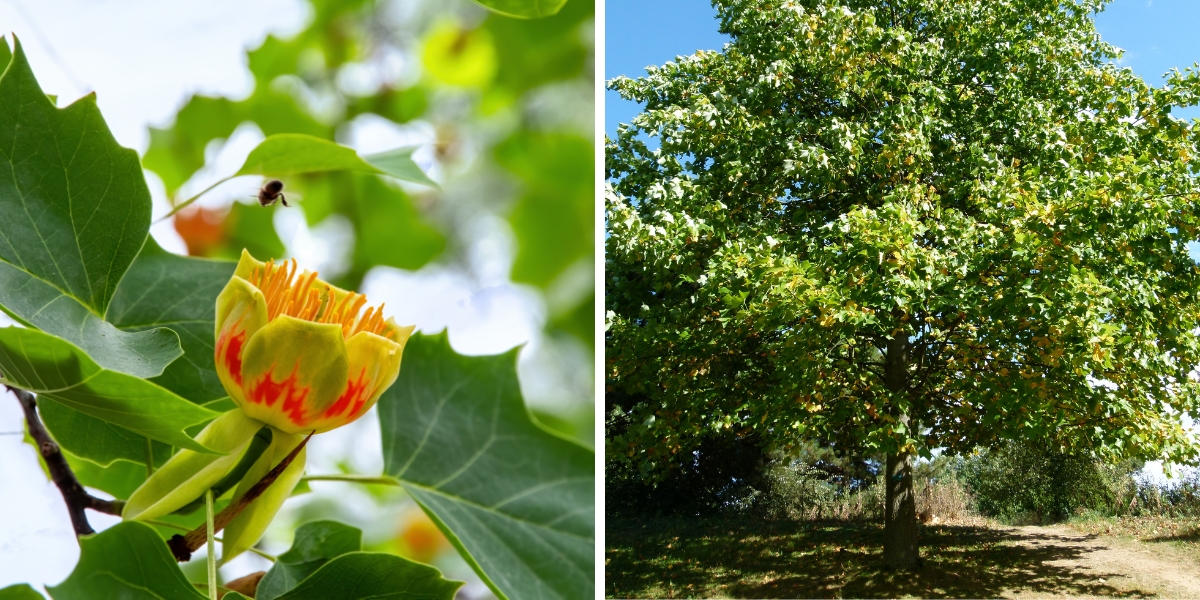
Right: a flower in bloom of a tuliptree
Left: Mature tuliptree towering over the surrounding canopy
2. Tuliptree (Liriodendron tulipifera)
Also known as the tulip poplar, the yellow poplar, and the state tree of Kentucky, the tuliptree (Liriodendron tulipifera) is the tallest hardwood species native to the eastern United States, often reaching heights of 70-90 feet. Tulip trees have been recorded as high as 187.5 feet tall.
This is an excellent shade tree for larger lots but should not be planted in smaller or average-sized lots here in the Cincinnati area. Make sure to plant tulip trees far from power lines.
Trees turn a vibrant golden yellow in the fall, making this a popular choice for homeowners with enough space.
Tuliptrees are not actually related to tulips or poplars, as their common names might suggest. Rather, the name comes from the showy, tulip-shaped flowers that bloom in early summer. They are an important pollen and nectar source, as they are often visited by ruby-throated hummingbirds and many native bee species.
These massive native Ohio trees also produce 3-inch-long clusters of fruit that disperse seeds into the wind in the fall. Squirrels feed on the seeds, as do overwintering birds.
Tuliptrees are also a host plant of the eastern tiger swallowtail butterfly as well as the stunning tulip tree silkmoth.
Tuliptree at a Glance
- Mature height – 70-90 feet
- Mature width – 35-50 feet
- Light exposure – Full sun to part sun
- Soil preferences – Moist, well-drained, acidic soils
- Growth rate – Fast
- Foliage – Deciduous
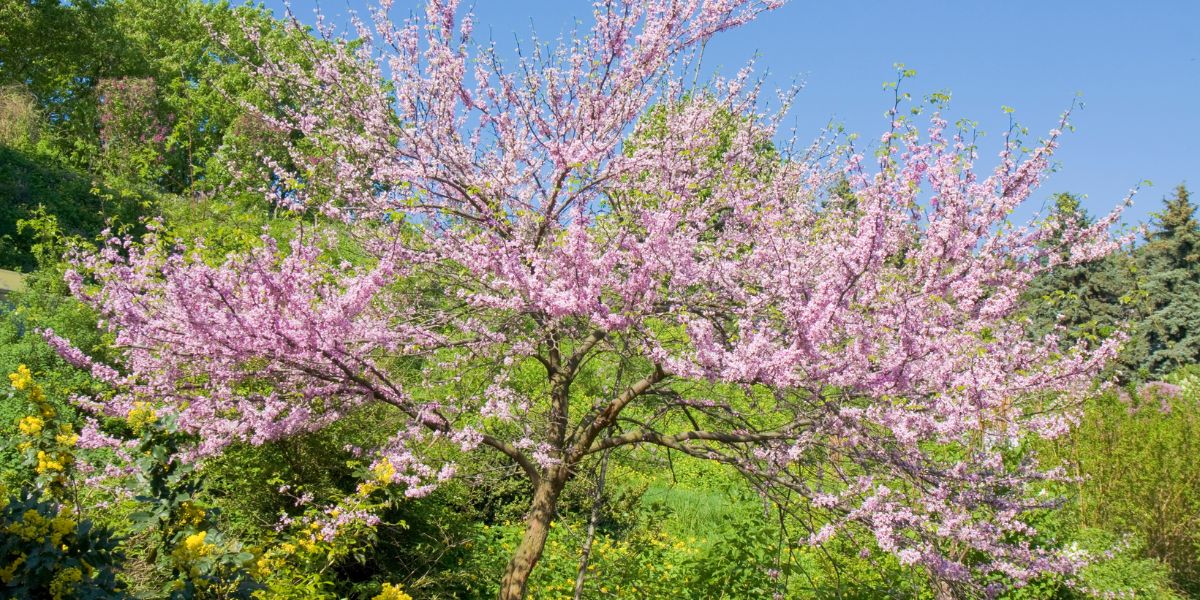
Eastern redbud blooming in early spring.
3. Eastern Redbud (Cercis canadensis)
Eastern redbuds (Cercis canadensis) are smaller flowering trees native to Ohio and northern Kentucky. They produce a showy display of vibrant pink flowers in the spring. The pink flowers signal the arrival of spring before most trees put out new leaves.
With enough space, it’s often recommended to plant eastern redbuds next to serviceberries (or flowering dogwoods) to create a stunning contrast of colors in the spring.
This is another understory tree you’ll often see on roadsides and in parks. They should be planted in areas that receive a lot of sun to encourage heavy flowering. Because the redbud flowers appear before most trees put out leaves, these trees are an important early food source for pollinators, from carpenter bees to hummingbirds. Eastern redbuds also serve dozens of butterfly and moth species as host plants and food sources.
The leaves turn bright yellow in the fall, adding to the appeal. The tree tends to grow multiple trunks with an attractive, broad branching structure. It forms a wide, open canopy making this ideal for more naturalistic settings.
Eastern Redbud at a Glance
- Mature height – 20-30 feet
- Mature width – 25-35 feet
- Light exposure – Full sun to part sun
- Soil preferences – Moist, well-drained soil
- Growth rate – Moderate
- Foliage – Deciduous
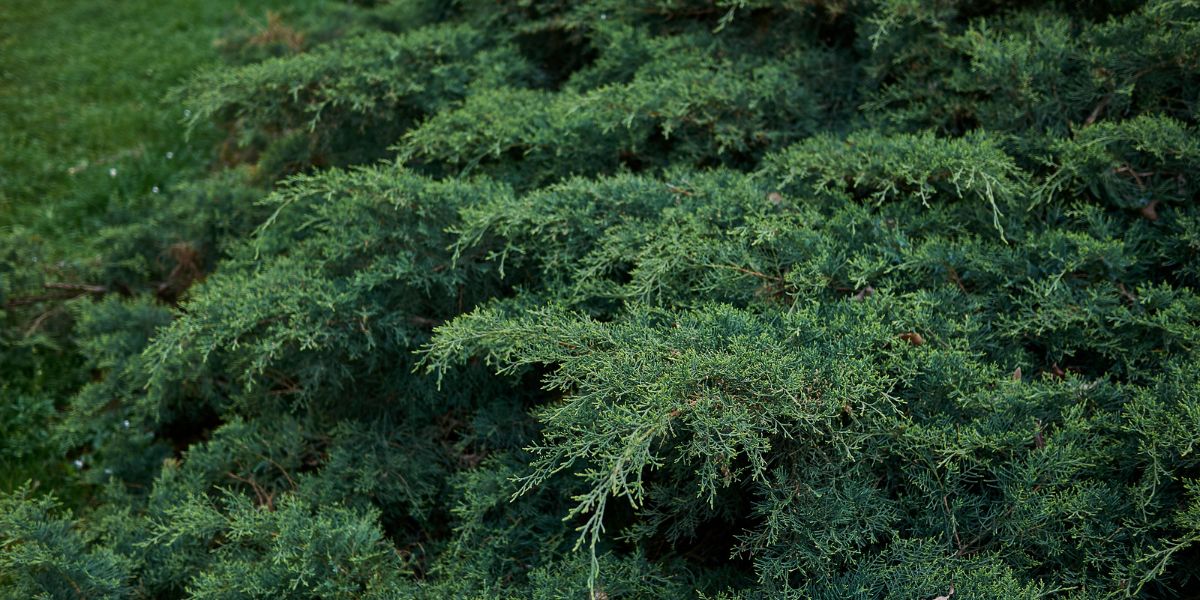
An eastern red cedar, a great tree for privacy or along property lines.
4. Eastern Red Cedar (Juniper virginiana)
Eastern red cedars (Juniper virginiana) are not actually cedars but are part of the juniper family. This medium-sized conifer is one of the most widespread native conifers in Ohio and is the most widely distributed native conifer in the eastern part of the US, making its home in 37 states.
Since the eastern red cedar is so dense, it’s often used as a privacy screen, lining the sides of yards to block unsightly views or fences. It’s also a valuable nesting site for birds year-round,
The prickly, fragrant foliage tends to brown in the winter. And the attractive blue-green cones are usually mistaken as berries. They show up in the late summer and fall and are an important food source for birds and small mammals. They contrast nicely against the dark green foliage, adding visual interest and signaling an end to warmer weather.
Eastern Red Cedar at a Glance
- Mature height – 40-50 feet
- Mature width – 8-20 feet
- Light exposure – Full sun
- Soil preferences – Dry or moist, well-drained soil
- Growth rate – Moderate
- Foliage – Evergreen
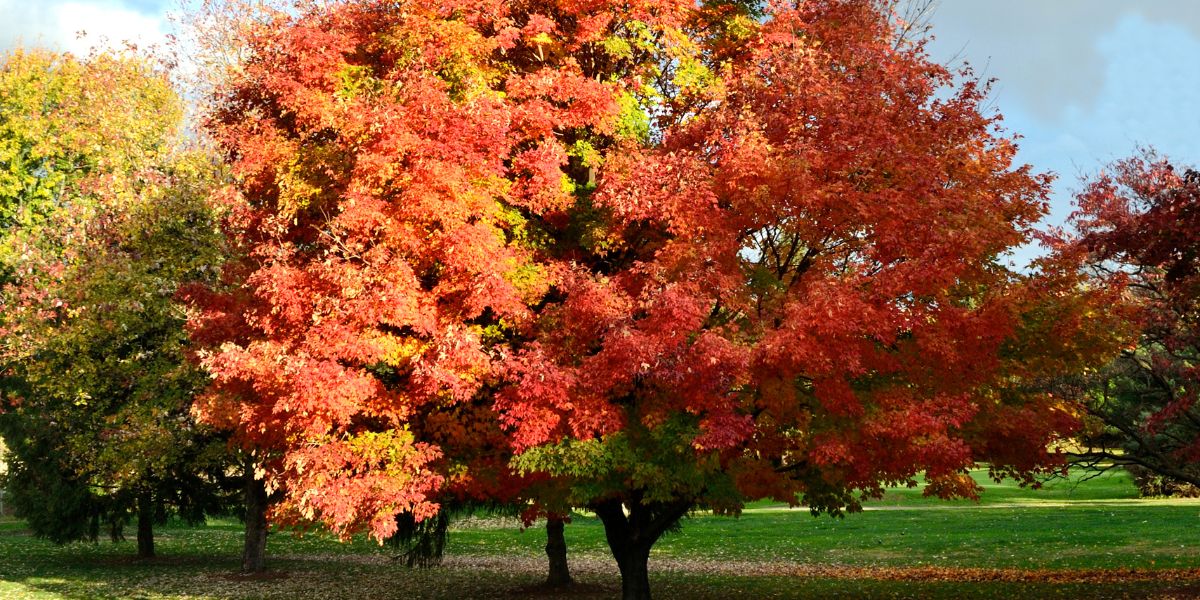
Maple trees are among the most dependable for beautiful fall colors.
5. Maples (Acer spp.)
Maples (Acer spp.) are a favorite, both commercially and residentially here in the Cincinnati area. They boast impressive fall foliage and are often used as street trees for showy displays of color.
Maples are often used as shade trees near homes. In the summer, they block sunlight, keeping homes cool. In the winter, as the leaves drop, sunlight is allowed to reach the home, warming it and lowering utility bills.
One of the biggest benefits of planting trees in your yard is supporting biodiversity. And maples make a big impact, hosting nearly 300 species of butterflies and moths. While the fruit of maples isn’t too popular with birds, it becomes an important food source during years of low seed and nut crops. More often, birds visit maples to feed on caterpillars or to nest in cavities on aging trees.
Sugar maples (A. saccharum) are the best producers of maple syrup, and we’ve seen more homeowners are tapping their trees and harvesting syrup as a hobby.
Red maples (A. Rubrum) are cherished for their striking red foliage in the fall, pyramidal shape, and fast growth habit. They’re perfect for formal landscapes.
Maples at a Glance
- Mature height – 60-75 feet
- Mature width – 40-50 feet
- Light exposure – Full sun to part shade
- Soil preferences – Moist, well-drained soil
- Growth rate – Fast
- Foliage – Deciduous
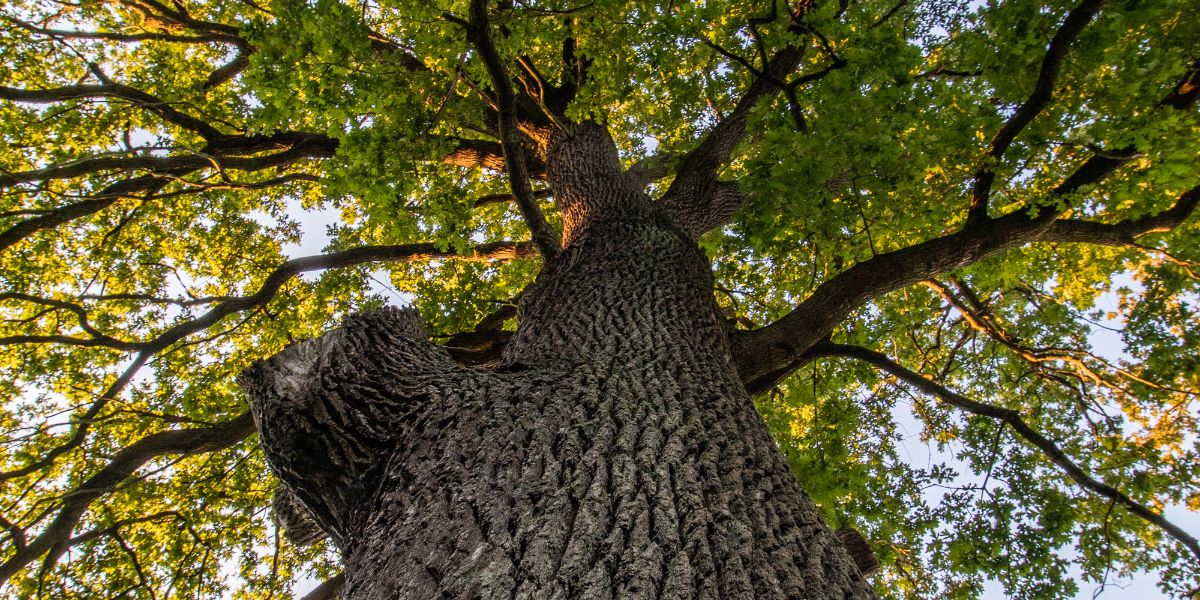
Oaks are among the most ecologically important trees in the country.
6. Oaks (Quercus spp.)
Oaks are one of the most ecologically important tree species in the US, supporting a wide range of wildlife. In general, oaks boast a long life span, often over 100 years, making them a worthwhile investment for both residential and commercial property owners.
Speaking of investment, mature oaks (along with other larger tree species) have been shown to increase property values, helping homeowners earn more when they sell their homes. Mature oaks on the west or south side of the home can also shade the house, cool the outside air, and help reduce energy costs.
The oak genus supports over 500 species of butterflies and moths. This makes it especially important for birds as well, as many native songbirds rely mostly or exclusively on caterpillars as a food source. If you want to wake up to the sound of birds singing, or enjoy the sight of butterflies in the yard, plant an oak tree.
And don’t forget about acorns. These are a valuable food source for various mammals and birds, from squirrels and deer to wild turkeys.
Oaks vary widely in size and form. White oaks (Quercus alba, 60-80 feet) need plenty of space, as their canopies can stretch over 100 feet in width at maturity. They produce some of the best fall colors.
Shumard oak (Quercus shumardii, 60-90 feet) is popular near busy roads and in larger cities like Cincinnati thanks to its tolerance of air pollution and adaptability to a range of soil conditions.
The Scarlet oak (Quercus coccinea, 50-80 feet) is known for its deep red color in the fall. While most native oaks in our area prefer moist soil, the scarlet oak prefers dry sites.
Call Lefke for Native Tree Recommendations
As Cincinnati’s most trusted tree service company, we are extremely familiar with each tree listed above, as well as countless other trees native to Cincinnati and Northern Kentucky. We know what makes these trees thrive and where to best plant them.
Most importantly, we know how to care for growing trees to ensure a long and useful life that minimizes expenses and the risks of damage.
If you need native tree recommendations for your Cincinnati landscape and want to ensure you plant them in a location that won’t require extensive maintenance or removal down the line, give us a call at 513-325-1783 or use this form to send us your tree care questions.

